Monitoring of Reinforced Concrete Corrosion: Active and Passive Bars Exposed to Climate
Abstract
1. Introduction
2. Methodology
2.1. Components and Exposure Class
2.2. Climate
3. Results
3.1. Corrosion Parameters of the Beam without Chlorides
3.2. Corrosion Parameters of the Beam with Chlorides
3.3. Corrosion Parameters of the Tendon
4. Discussion
5. Conclusions
Author Contributions
Funding
Institutional Review Board Statement
Informed Consent Statement
Data Availability Statement
Conflicts of Interest
References
- Xia, J.; Li, T.; Fang, J.-X.; Jin, W. Numerical Simulation of Steel Corrosion in Chloride Contaminated Concrete. Constr. Build. Mater. 2019, 228, 116745. [Google Scholar] [CrossRef]
- Hou, B.; Li, X.; Ma, X.; Du, C.; Zhang, D.; Zheng, M.; Xu, W.; Lu, D.; Ma, F. The Cost of Corrosion in China. NPJ Mater. Degrad. 2017, 1, 4. [Google Scholar] [CrossRef]
- Schueremans, L.; Van Gemert, D.; Giessler, S. Chloride Penetration in RC-Structures in Marine Environment—Long Term Assessment of a Preventive Hydrophobic Treatment. Constr. Build. Mater. 2007, 21, 1238–1249. [Google Scholar] [CrossRef]
- Val, D.V.; Stewart, M.G. Life-Cycle Cost Analysis of Reinforced Concrete Structures in Marine Environments. Struct. Saf. 2003, 25, 343–362. [Google Scholar] [CrossRef]
- Zhu, W.; François, R.; Fang, Q.; Zhang, D. Influence of Long-Term Chloride Diffusion in Concrete and the Resulting Corrosion of Reinforcement on the Serviceability of RC Beams. Cem. Concr. Compos. 2016, 71, 144–152. [Google Scholar] [CrossRef]
- Wei, J.; Wang, C.-G.; Wei, X.; Mu, X.; He, X.-Y.; Dong, J.-H.; Ke, W. Corrosion Evolution of Steel Reinforced Concrete under Simulated Tidal and Immersion Zones of Marine Environment. Acta Metall. Sin. (Engl. Lett.) 2019, 32, 900–912. [Google Scholar] [CrossRef]
- Sanchez, J.; Fullea, J.; Andrade, C. Corrosion-Induced Brittle Failure in Reinforcing Steel. Theor. Appl. Fract. Mech. 2017, 92, 229–232. [Google Scholar] [CrossRef]
- Sanchez, J.; Fullea, J.; Andrade, C. Fracto-Surface Mobility Mechanism in High-Strength Steel Wires. Eng. Fract. Mech. 2017, 186, 410–422. [Google Scholar] [CrossRef]
- Franceschini, L.; Vecchi, F.; Tondolo, F.; Belletti, B.; Sánchez Montero, J. Mechanical Behaviour of Corroded Strands under Chloride Attack: A New Constitutive Law. Constr. Build. Mater. 2022, 316, 125872. [Google Scholar] [CrossRef]
- Vecchi, F.; Franceschini, L.; Tondolo, F.; Belletti, B.; Sánchez Montero, J.; Minetola, P. Corrosion Morphology of Prestressing Steel Strands in Naturally Corroded PC Beams. Constr. Build. Mater. 2021, 296, 123720. [Google Scholar] [CrossRef]
- Franceschini, L.; Vecchi, F.; Tondolo, F.; Belletti, B.; Montero, J.S.; Minetola, P. Proceedings of the Variability in Section Loss and Maximum Pit Depth of Corroded Prestressing Wires BT—Proceedings of the 1st Conference of the European Association on Quality Control of Bridges and Structures, Espoo, Finland, 25–27 January 2023; Pellegrino, C., Faleschini, F., Zanini, M.A., Matos, J.C., Casas, J.R., Strauss, A., Eds.; Springer International Publishing: Cham, Switzerland, 2022; pp. 491–498. [Google Scholar]
- Parkins, R.N.; Elices, M.; Sanchez-Galvez, V.; Caballero, L. Environment Sensitive Cracking of Pre-Stressing Steels. Corros. Sci. 1982, 22, 379–405. [Google Scholar] [CrossRef]
- Franceschini, L.; Belletti, B.; Tondolo, F.; Sanchez Montero, J. A Simplified Stress–Strain Relationship for the Mechanical Behavior of Corroded Prestressing Strands: The SCPS-Model. Struct. Concr. 2023, 24, 189–210. [Google Scholar] [CrossRef]
- Sanchez, J.; Fullea, J.; Andrade, C. Stress Corrosion Cracking of High Strength Steels. In 1st International RILEM PhD Student Workshop on Modelling the Durability of Reinforced Concrete; Gulikers, J., Andrade, C., Eds.; National Repository Library: Madrid, India, 2007. [Google Scholar]
- Sanchez, J.; Fullea, J.; Andrade, C.; De Andres, P.L. Hydrogen in α-Iron: Stress and Diffusion. Phys. Rev. B Condens. Matter Mater. Phys. 2008, 78, 014113. [Google Scholar] [CrossRef]
- Sanchez, J.; Fullea, J.; Andrade, C.; Alonso, C. Stress Corrosion Cracking Mechanism of Prestressing Steels in Bicarbonate Solutions. Corros. Sci. 2007, 49, 4069–4080. [Google Scholar] [CrossRef]
- Sanchez, J.; Fullea, J.; Andrade, C. Fracture Toughness Variation Induced by Stress Corrosion Cracking of Prestressing Steels. Mater. Corros. 2008, 59, 139–143. [Google Scholar] [CrossRef]
- Sanchez, J.; Andrade, C.; Fullea, J. Reasons for Crack Arrest in Stress Corrosion Cracking Tests—Crack Propagation Rate in High-Strength Steels. Corrosion 2009, 65, 368–375. [Google Scholar] [CrossRef]
- Torres Martín, J.E.; Rebolledo Ramos, N.; Chinchón-Payá, S.; Helices Arcila, I.; Silva Toledo, A.; Sánchez Montero, J.; Llorente Sanjuán, M.; Agulló Soto, S.; Otero García, F.; de Haan, L. Durability of a Reinforced Concrete Structure Exposed to Marine Environment at the Málaga Dock. Case Stud. Constr. Mater. 2022, 17, e01582. [Google Scholar] [CrossRef]
- Gómez, P.S.; Montero, J.S.; Martín, J.E.T.; Chinchón-Payá, S.; Ramos, N.R. Decreased Useful Life in Air Chamber Reinforced Concrete Elements under Sanitary Floors by Carbonation Corrosion. Case Stud. Constr. Mater. 2023, 19, e02390. [Google Scholar] [CrossRef]
- Vecchi, F.; Belletti, B.; Franceschini, L.; Andrade, C.; Rodriguez, J.; Montero, S.J. Flexural Tests on Prestressed Beams Exposed to Natural Chloride Action. In Fib CACRCS DAYS 2020; FIB: Los Santos, Panama, 2021; pp. 205–212. [Google Scholar]
- Belletti, B.; Rodríguez, J.; Andrade, C.; Franceschini, L.; Sánchez Montero, J.; Vecchi, F. Experimental Tests on Shear Capacity of Naturally Corroded Prestressed Beams. Struct. Concr. 2020, 21, 1777–1793. [Google Scholar] [CrossRef]
- Rebolledo, N.; Torres, J.; Chinchón-Payá, S.; Sánchez, J.; de Gregorio, S.; Ordóñez, M.; López, I. Monitoring in a Reinforced Concrete Structure for Storing Low and Intermediate Level Radioactive Waste. Lessons Learnt after 25 Years. Nucl. Eng. Technol. 2023, 55, 1199–1209. [Google Scholar] [CrossRef]
- Sanchez, J.; Andrade, C.; Fullea, J. Hydrothermal Monitoring Using Embedded Sensors of the Actual Roof System of the Prado Museum. Constr. Build. Mater. 2010, 24, 2579–2589. [Google Scholar] [CrossRef]
- Andrade, C.; Martinez, I.; Castellote, M.; Zuloaga, P. Some Principles of Service Life Calculation of Reinforcements and in Situ Corrosion Monitoring by Sensors in the Radioactive Waste Containers of El Cabril Disposal (Spain). J. Nucl. Mater. 2006, 358, 82–95. [Google Scholar] [CrossRef]
- Vennesland, Ø.; Raupach, M.; Andrade, C. Recommendation of Rilem TC 154-EMC: “Electrochemical Techniques for Measuring Corrosion in Concrete”—Measurements with Embedded Probes. Mater. Struct. 2007, 40, 745–758. [Google Scholar] [CrossRef]
- Polder, R.; Andrade, C.; Elsener, B.; Vennesland, Ø.; Gulikers, J.; Weidert, R.; Raupach, M. Test Methods for on Site Measurement of Resistivity of Concrete. Mater. Struct. 2000, 33, 603–611. [Google Scholar] [CrossRef]
- Angst, U.; Moro, F.; Geiker, M.; Kessler, S.; Beushausen, H.; Andrade, C.; Lahdensivu, J.; Köliö, A.; Imamoto, K.; von Greve-Dierfeld, S.; et al. Corrosion of Steel in Carbonated Concrete: Mechanisms, Practical Experience, and Research Priorities—A Critical Review by RILEM TC 281-CCC. RILEM Tech. Lett. 2020, 5, 85–100. [Google Scholar] [CrossRef]
- Garcia, E.; Torres, J.; Rebolledo, N.; Arrabal, R.; Sanchez, J. Corrosion of Steel Rebars in Anoxic Environments. Part I: Electrochemical Measurements. Materials 2021, 14, 2491. [Google Scholar] [CrossRef]
- Warkus, J.; Raupach, M.; Gulikers, J. Numerical Modelling of Corrosion—Theoretical Backgrounds. Mater. Corros. 2006, 57, 614–617. [Google Scholar] [CrossRef]
- Sanchez, J.; Andrade, C.; Torres, J.; Rebolledo, N.; Fullea, J. Determination of Reinforced Concrete Durability with On-Site Resistivity Measurements. Mater. Struct. 2017, 50, 41. [Google Scholar] [CrossRef]
- Garcia, E.; Torres, J.; Rebolledo, N.; Arrabal, R.; Sanchez, J. Corrosion of Steel Rebars in Anoxic Environments. Part II: Pit Growth Rate and Mechanical Strength. Materials 2021, 14, 2547. [Google Scholar] [CrossRef]
- Andrade, C.; Sanchez, J.; Fullea, J.; Rebolledo, N.; Tavares, F. On-Site Corrosion Rate Measurements: 3D Simulation and Representative Values. Mater. Corros. 2012, 63, 1154–1164. [Google Scholar] [CrossRef]
- Feliu, S.; Gonzalez, J.A.; Andrade, C.; Rzmaribona, I. Errors Introduced by the Guard Ring Device in the On-Site Measurement of Rebar Corrosion Rates; Page, C.L., Treadaway, K.W.J., Bamforth, P.B., Eds.; CICC Publications: Kerala, India, 1990; ISBN 1-85166-487-4. [Google Scholar]
- Garzon, A.J.; Sanchez, J.; Andrade, C.; Rebolledo, N.; Menéndez, E.; Fullea, J. Modification of Four Point Method to Measure the Concrete Electrical Resistivity in Presence of Reinforcing Bars. Cem. Concr. Compos. 2014, 53, 249–257. [Google Scholar] [CrossRef]
- Keddam, M.; Nóvoa, X.R.; Puga, B.; Vivier, V. Impedance Based Method for Non-Contact Determination of the Corrosion Rate in Buried Metallic Structures. Eur. J. Environ. Civil. Eng. 2011, 15, 1097–1103. [Google Scholar] [CrossRef]
- Andrade, C.; Sanchez, J.; Martinez, I.; Rebolledo, N. Analogue Circuit of the Inductive Polarization Resistance. Electrochim. Acta 2011, 56, 1874–1880. [Google Scholar] [CrossRef]
- Caneda-Martínez, L.; Frías, M.; Medina, C.; de Rojas, M.I.S.; Rebolledo, N.; Sánchez, J. Evaluation of Chloride Transport in Blended Cement Mortars Containing Coal Mining Waste. Constr. Build. Mater. 2018, 190, 200–210. [Google Scholar] [CrossRef]
- Morales, J.A.; Torres, J.; Rebolledo, N.; Sánchez, J. Experimental and Statistical Analysis of the Corrosion in Tendons in Contact With Water. Front. Mater. 2019, 6, 167. [Google Scholar] [CrossRef]
- Hornbostel, K.; Larsen, C.K.; Geiker, M.R. Relationship between Concrete Resistivity and Corrosion Rate—A Literature Review. Cem. Concr. Compos. 2013, 39, 60–72. [Google Scholar] [CrossRef]
- Garzon, A.J.; Andrade, C.; Rebolledo, N.; Fullea, J.; Sanchez, J.; Menéndez, E. Shape Factors of Four Point Resistivity Method in Presence of Rebars. In Proceedings of the Concrete Repair, Rehabilitation and Retrofitting III—Proceedings of the 3rd International Conference on Concrete Repair, Rehabilitation and Retrofitting, ICCRRR 2012, Cape Town, South Africa, 3–5 September 2012; pp. 695–700. [Google Scholar]
- Gulikers, J. Theoretical Considerations on the Supposed Linear Relationship between Concrete Resistivity and Corrosion Rate of Steel Reinforcement. Mater. Corros. 2005, 56, 393–403. [Google Scholar] [CrossRef]
- Keßler, S.; Fischer, J.; Straub, D.; Gehlen, C. Updating of Service-Life Prediction of Reinforced Concrete Structures with Potential Mapping. Cem. Concr. Compos. 2014, 47, 47–52. [Google Scholar] [CrossRef]
- Keßler, S. Probabilistic Corrosion Condition Assessment of a Tunnel Structure. Struct. Concr. 2020, 21, 1345–1355. [Google Scholar] [CrossRef]
- De Domenico, D.; Messina, D.; Recupero, A. Seismic Vulnerability Assessment of Reinforced Concrete Bridge Piers with Corroded Bars. Struct. Concr. 2023, 24, 56–83. [Google Scholar] [CrossRef]
- Villagrán Zaccardi, Y.A.; Alderete, N.M.; De Belie, N. Improved Model for Capillary Absorption in Cementitious Materials: Progress over the Fourth Root of Time. Cem. Concr. Res. 2017, 100, 153–165. [Google Scholar] [CrossRef]
- Alderete, N.M.; Villagrán Zaccardi, Y.A.; De Belie, N. Mechanism of Long-Term Capillary Water Uptake in Cementitious Materials. Cem. Concr. Compos. 2020, 106, 103448. [Google Scholar] [CrossRef]
- Sanchez, J.; Lee, S.F.; Martin-Rengel, M.A.; Fullea, J.; Andrade, C.; Ruiz-Hervías, J. Measurement of Hydrogen and Embrittlement of High Strength Steels. Eng. Fail. Anal. 2016, 59, 467–477. [Google Scholar] [CrossRef]
- Sanchez, J.; Ridruejo, A.; de Andres, P.L. Diffusion and Trapping of Hydrogen in Carbon Steel at Different Temperatures. Theor. Appl. Fract. Mech. 2020, 110, 102803. [Google Scholar] [CrossRef]
- Castedo, A.; Sanchez, J.; Fullea, J.; Andrade, C.; de Andres, P.L. Hydrogen Induced Changes in Structural Properties of Iron: Ab Initio Calculations; Springer Netherlands: Dordrecht, The Netherlands, 2012; Volume 3, ISBN 9789400727021. [Google Scholar]
- Sanchez, J.; Fullea, J.; Andrade, M.C.; De Andres, P.L. Ab Initio Molecular Dynamics Simulation of Hydrogen Diffusion in α-Iron. Phys. Rev. B Condens. Matter Mater. Phys. 2010, 81, 132102. [Google Scholar] [CrossRef]
- de Andres, P.L.; Sanchez, J.; Ridruejo, A. Hydrogen in α-Iron: Role of Phonons in the Diffusion of Interstitials at High Temperature. Sci. Rep. 2019, 9, 12127. [Google Scholar] [CrossRef]
- Castedo, A.; Sanchez, J.; Fullea, J.; Andrade, M.C.; De Andres, P.L. Ab Initio Study of the Cubic-to-Hexagonal Phase Transition Promoted by Interstitial Hydrogen in Iron. Phys. Rev. B Condens. Matter Mater. Phys. 2011, 84, 094101. [Google Scholar] [CrossRef]
- Turnbull, A.; McCartney, L.N.; Zhou, S. Modelling of the Evolution of Stress Corrosion Cracks from Corrosion Pits. Scr. Mater. 2006, 54, 575–578. [Google Scholar] [CrossRef]
- Franceschini, L.; Belletti, B.; Tondolo, F.; Sanchez, J. Study on the Probability Distribution of Pitting for Naturally Corroded Prestressing Strands Accounting for Surface Defects. Buildings 2022, 12, 1732. [Google Scholar] [CrossRef]
- Geiker, M.R.; Hendriks, M.A.N.; Elsener, B. Durability-Based Design: The European Perspective. Sustain. Resilient Infrastruct. 2023, 8, 169–184. [Google Scholar] [CrossRef]
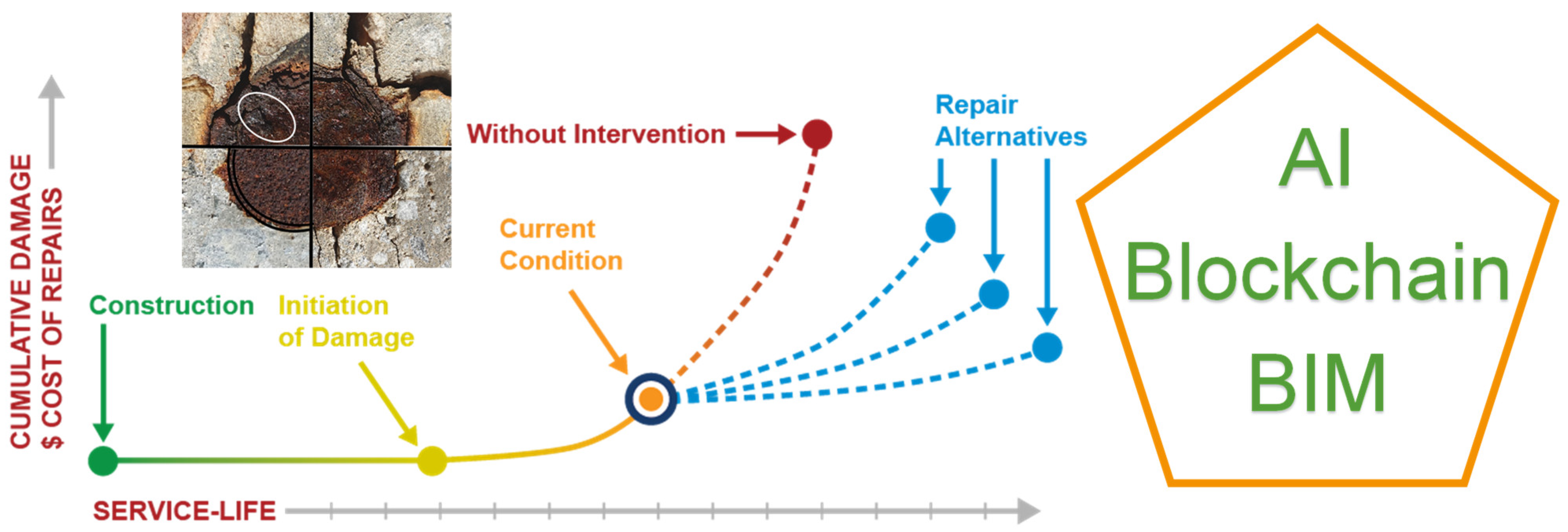

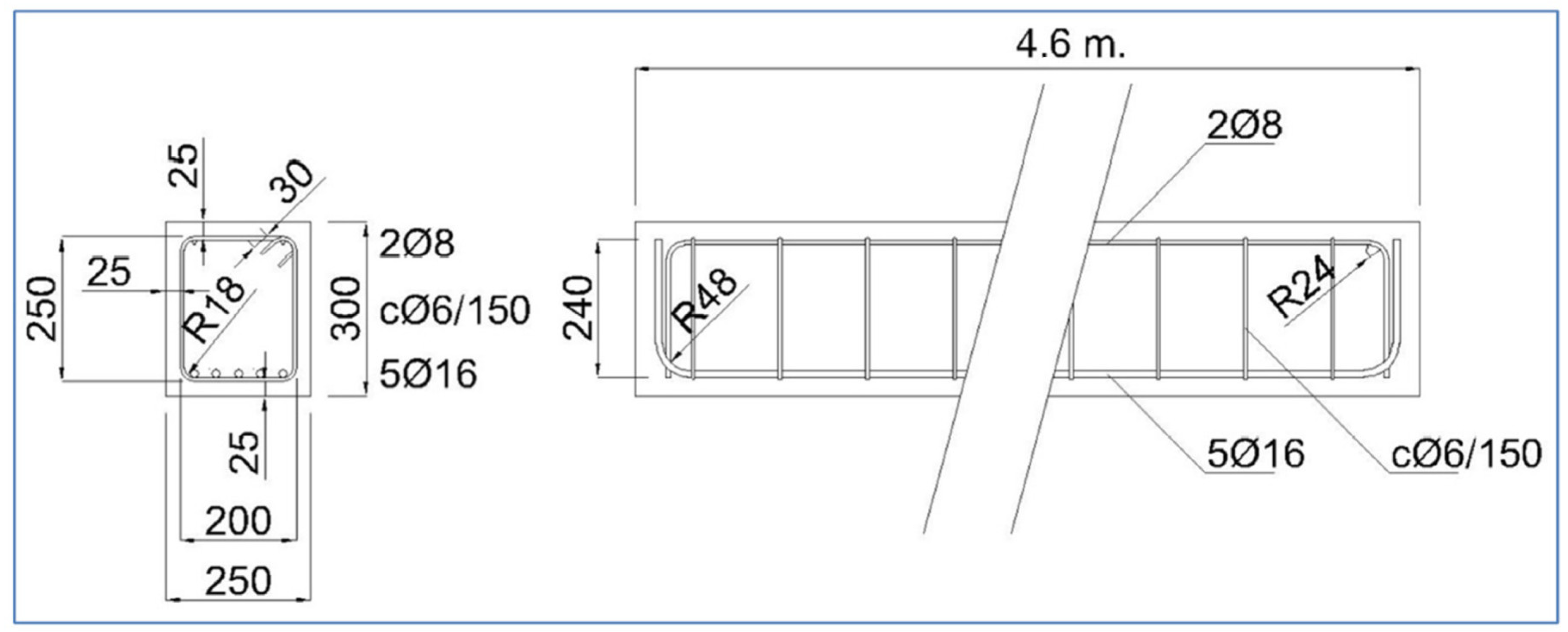

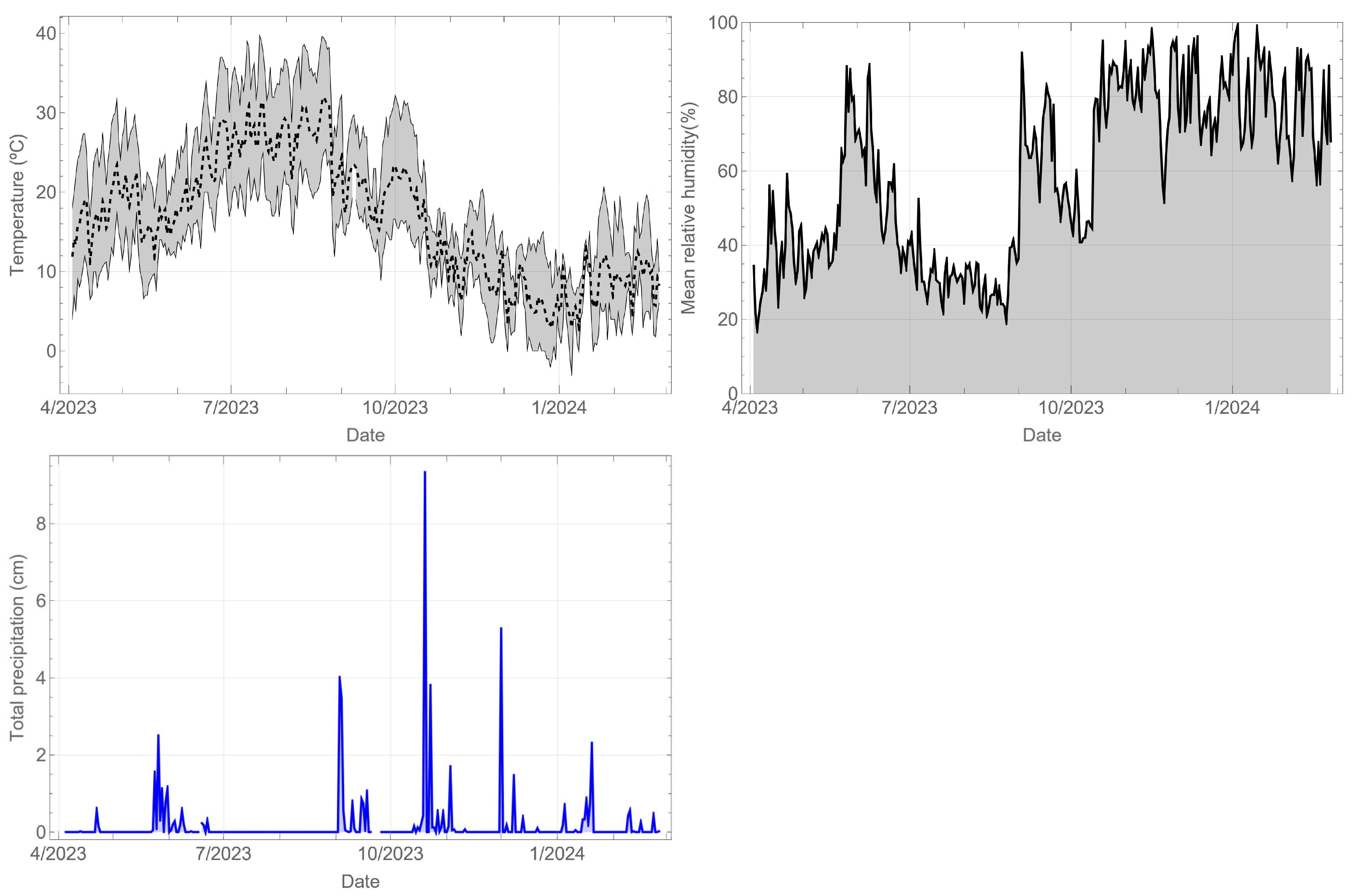
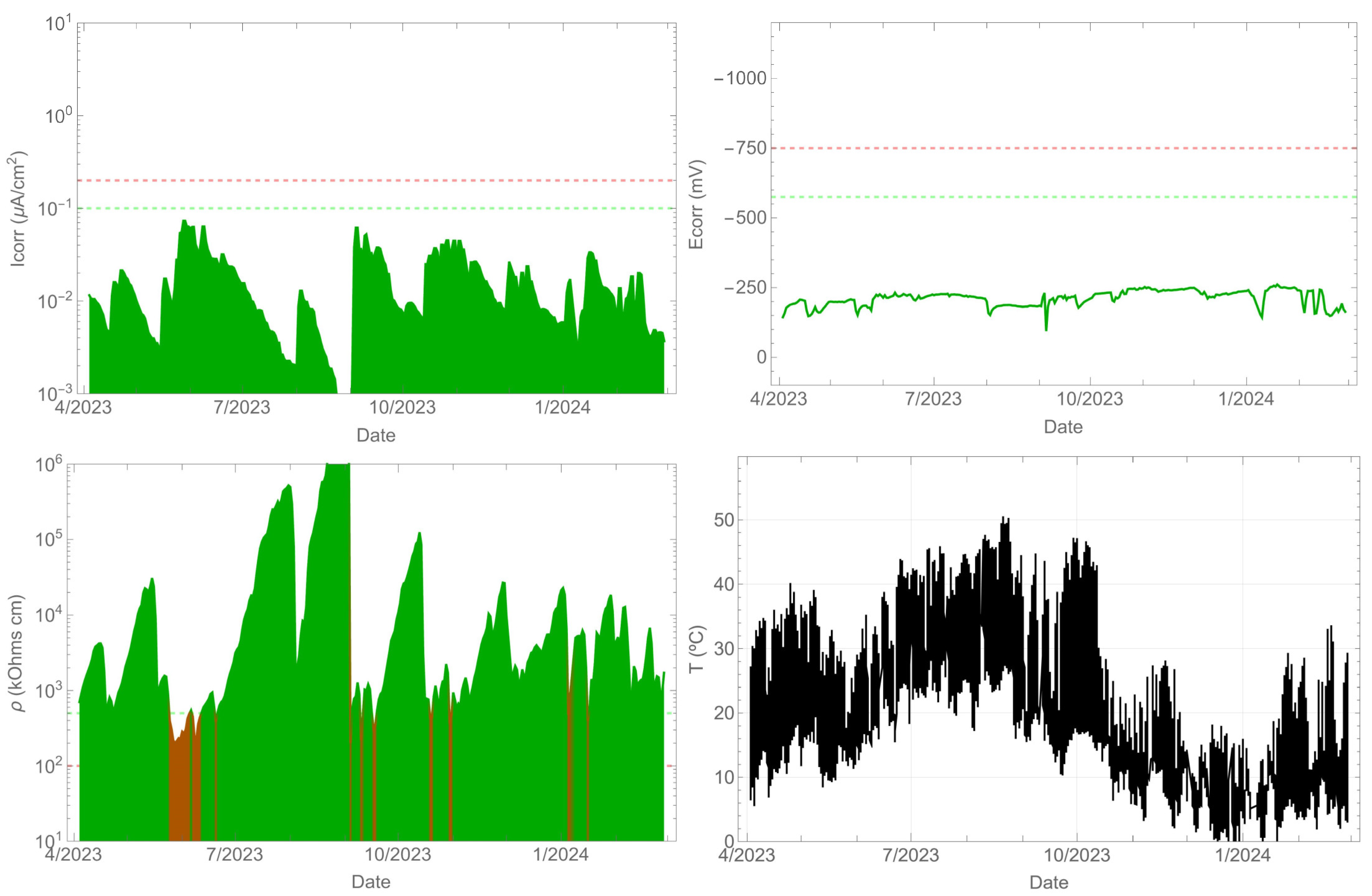
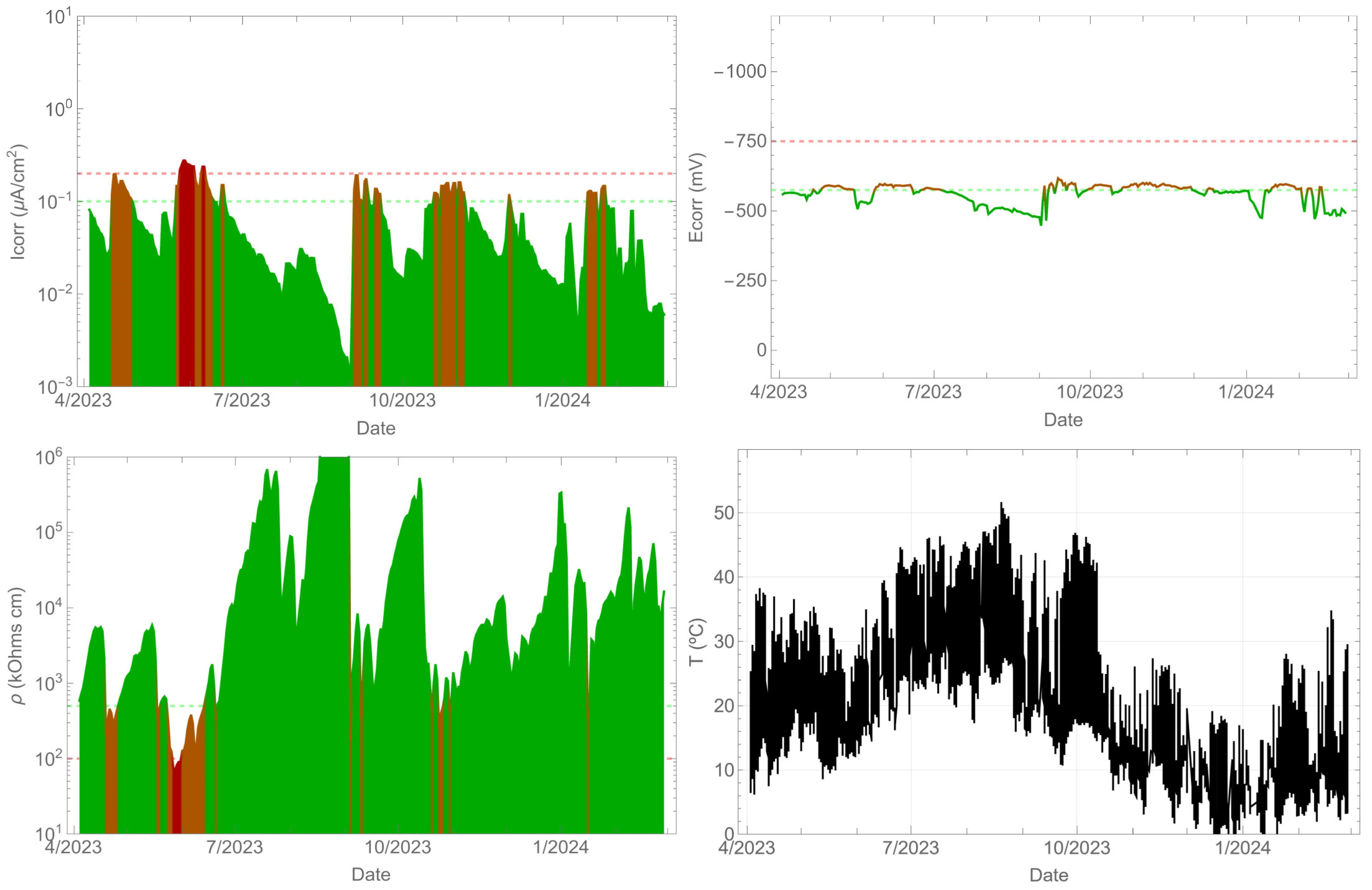

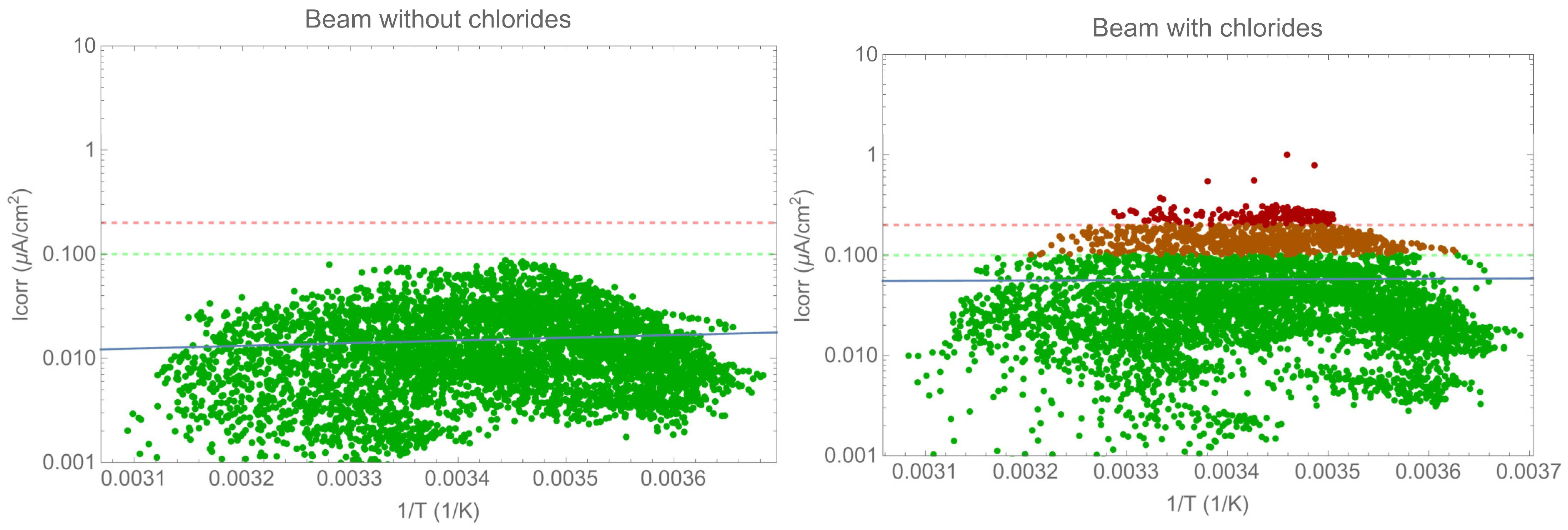
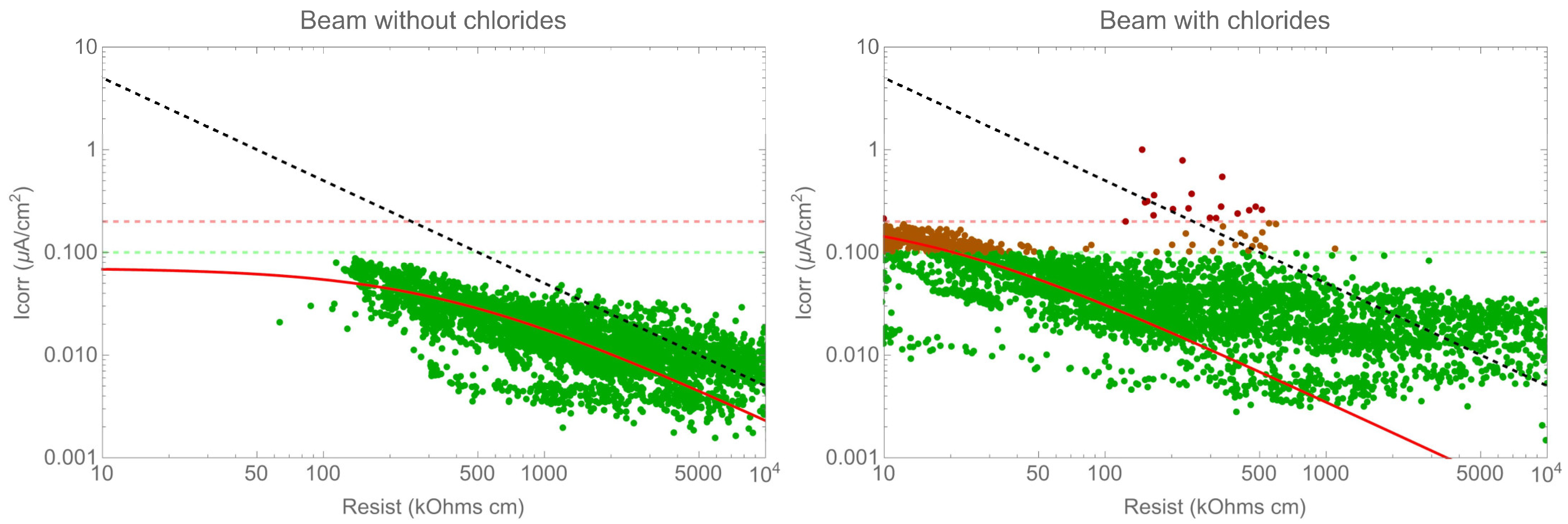
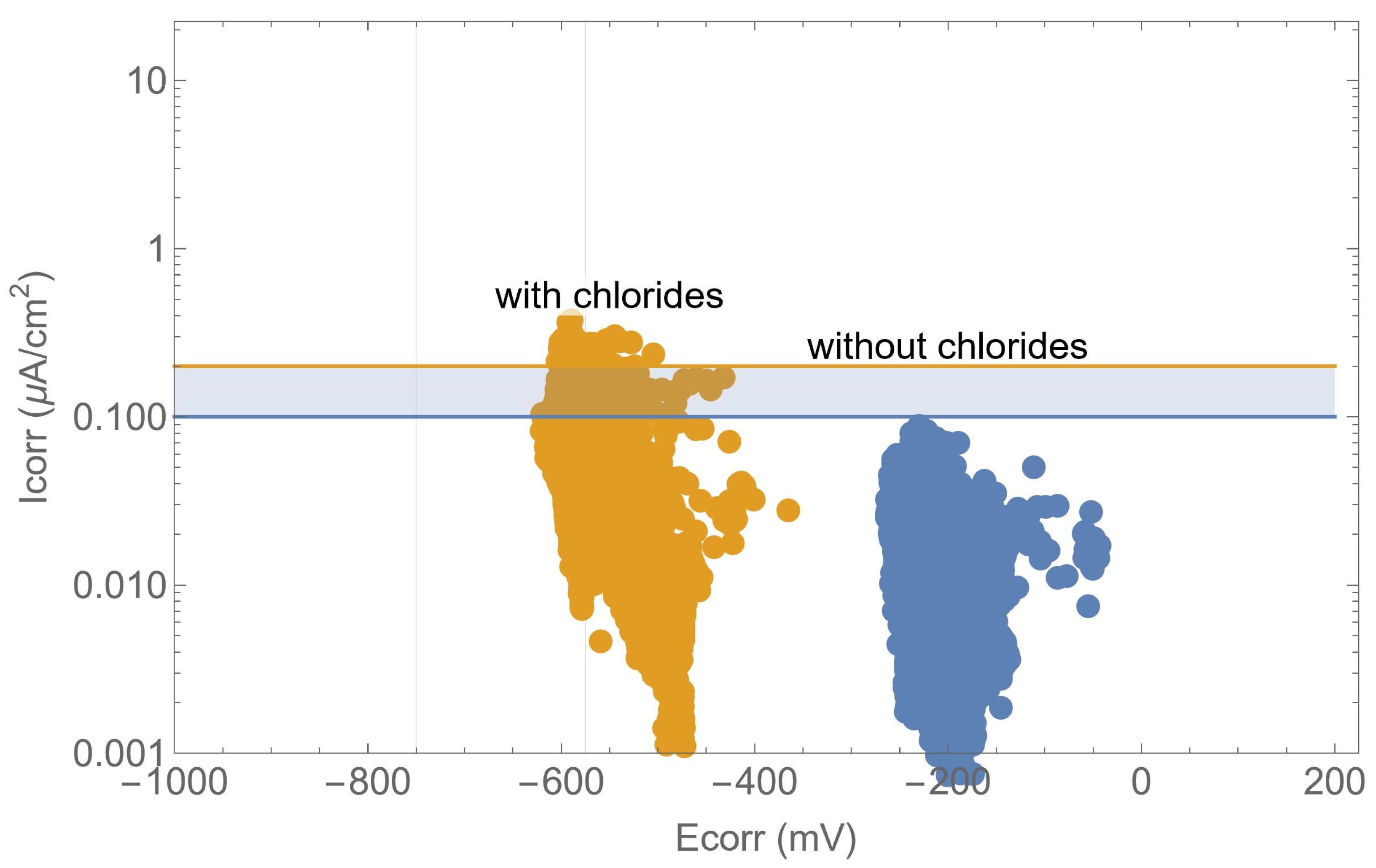
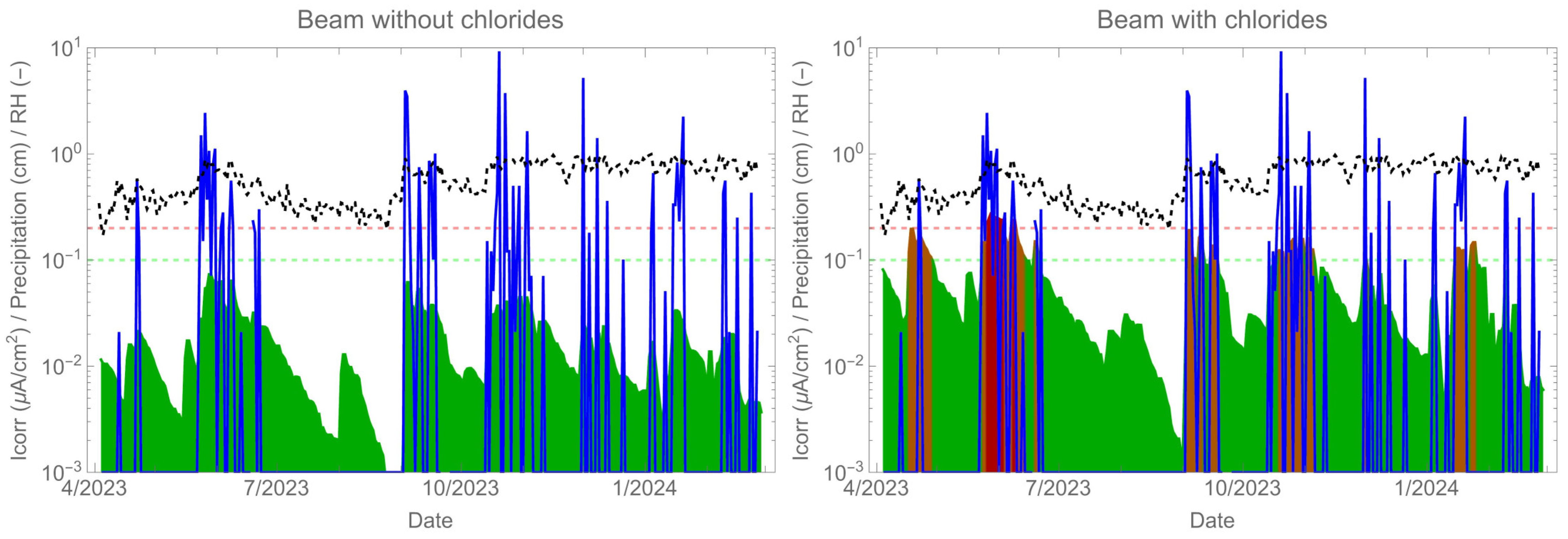
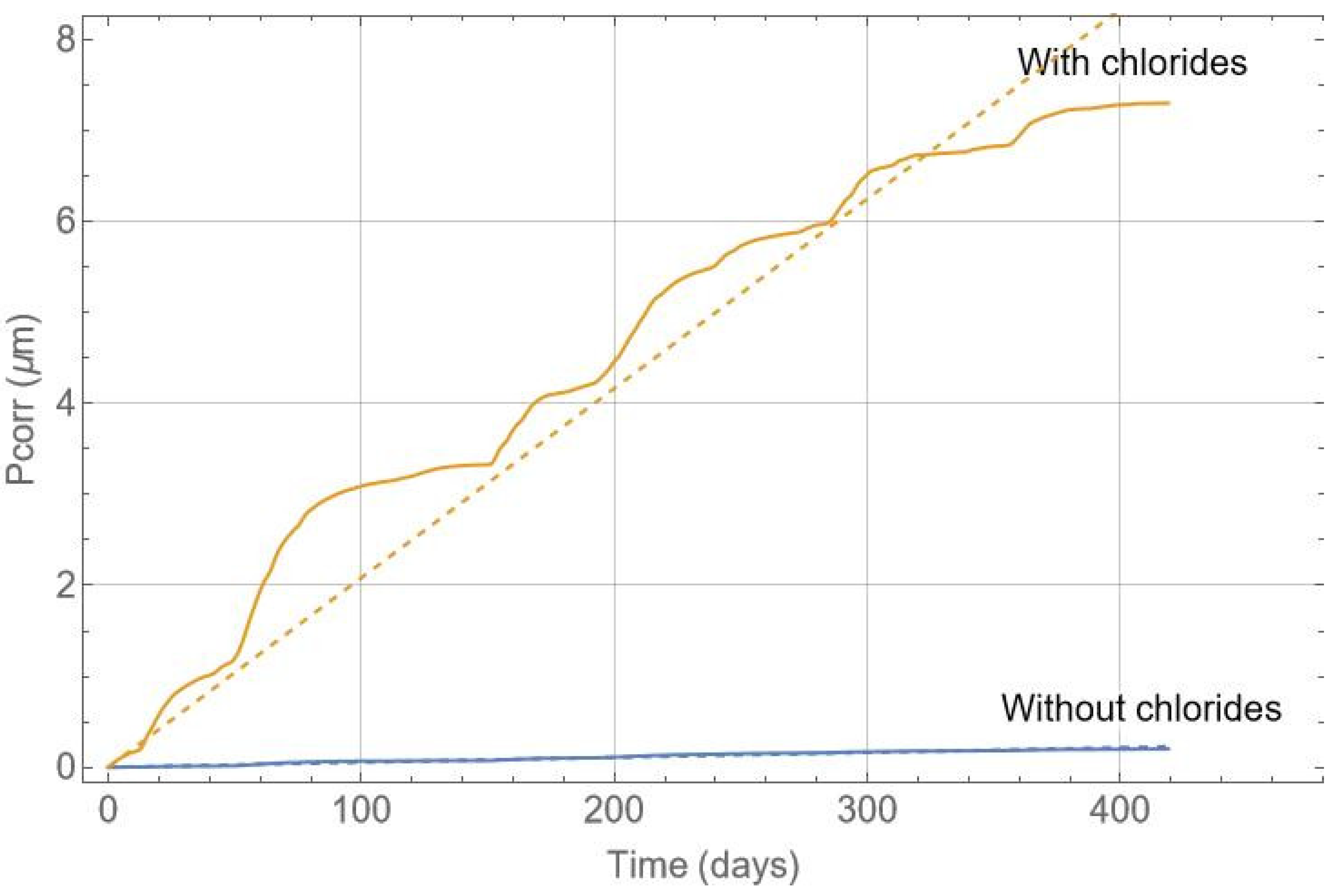
Disclaimer/Publisher’s Note: The statements, opinions and data contained in all publications are solely those of the individual author(s) and contributor(s) and not of MDPI and/or the editor(s). MDPI and/or the editor(s) disclaim responsibility for any injury to people or property resulting from any ideas, methods, instructions or products referred to in the content. |
© 2024 by the authors. Licensee MDPI, Basel, Switzerland. This article is an open access article distributed under the terms and conditions of the Creative Commons Attribution (CC BY) license (https://creativecommons.org/licenses/by/4.0/).
Share and Cite
Rebolledo, N.; Torres, J.E.; Silva, A.; Sánchez, J. Monitoring of Reinforced Concrete Corrosion: Active and Passive Bars Exposed to Climate. Appl. Sci. 2024, 14, 4665. https://doi.org/10.3390/app14114665
Rebolledo N, Torres JE, Silva A, Sánchez J. Monitoring of Reinforced Concrete Corrosion: Active and Passive Bars Exposed to Climate. Applied Sciences. 2024; 14(11):4665. https://doi.org/10.3390/app14114665
Chicago/Turabian StyleRebolledo, Nuria, Julio E. Torres, Antonio Silva, and Javier Sánchez. 2024. "Monitoring of Reinforced Concrete Corrosion: Active and Passive Bars Exposed to Climate" Applied Sciences 14, no. 11: 4665. https://doi.org/10.3390/app14114665
APA StyleRebolledo, N., Torres, J. E., Silva, A., & Sánchez, J. (2024). Monitoring of Reinforced Concrete Corrosion: Active and Passive Bars Exposed to Climate. Applied Sciences, 14(11), 4665. https://doi.org/10.3390/app14114665






